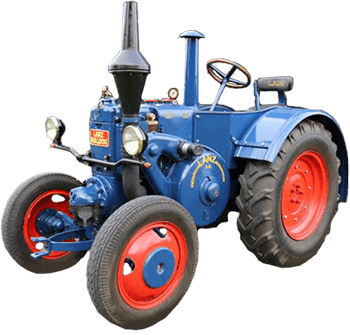December 3, 2020
A best seller: The late styled “B” So popular, it even surprised Deere
Story by Benjamin Hain.
Originally published in the February 2012 issue of Green Magazine, the #1 magazine for John Deere tractor, equipment, and memorabilia enthusiasts.
Follow this link, https://greenmagazine.com/ for more John Deere stories from Green Magazine.
A best seller: The late styled “B” So popular, it even surprised Deere

Deere certainly anticipated that improving and updating its popular model “B” would result in an increase in sales or else the company never would have done it. But surely it surprised even those at Deere when the re-release of the tractor as the styled version in 1939—with handsome Henry Dreyfuss-designed styling and a Waterloo-engineered horsepower increase—sent the model “B” into the position of the company’s best selling tractor. More improvements in 1941 served only to improve sales of the tractor even more. So popular was the model “B” that it was the only Deere tractor that had its production continue unceasingly throughout the material shortages and restrictions caused by World War II. Late in the war, though, sales of the model “B” began to wane and it became clear that more improvements would have to be made to the tractor to renew its popularity and keep it fresh and ready for whenever the war ended.
Much of Deere’s postwar success is directly attributable to orders placed by the company’s president, Charles Deere Wiman. Wiman, about to leave the company to serve in the military, stated that the company must continue its work in research and development. Wiman was around when Deere first started its investigations into what later became the model “D” and watched as the research done during the Great Depression produced the successful models “A” and “B.” He knew that, no matter what else may come, if Deere and Company maintained its research department and explored new avenues and technologies, when whatever tribulations the world went through were over, Deere would be ahead of the game when things got going again.
While research continued throughout World War II, specific development of new versions of the model “A” and “B” tractors officially began in late 1944. By this point, it was obvious that the war was not going to last much longer and Deere wanted to be sure to have its new tractors ready for the young farmers returning from overseas. The sales branch noted that electric lights and starting were in high demand. Deere had offered these components as add-on options but, as such, the systems were not well protected from the elements and reliability was unimpressive, so it was decided to make these systems standard equipment.
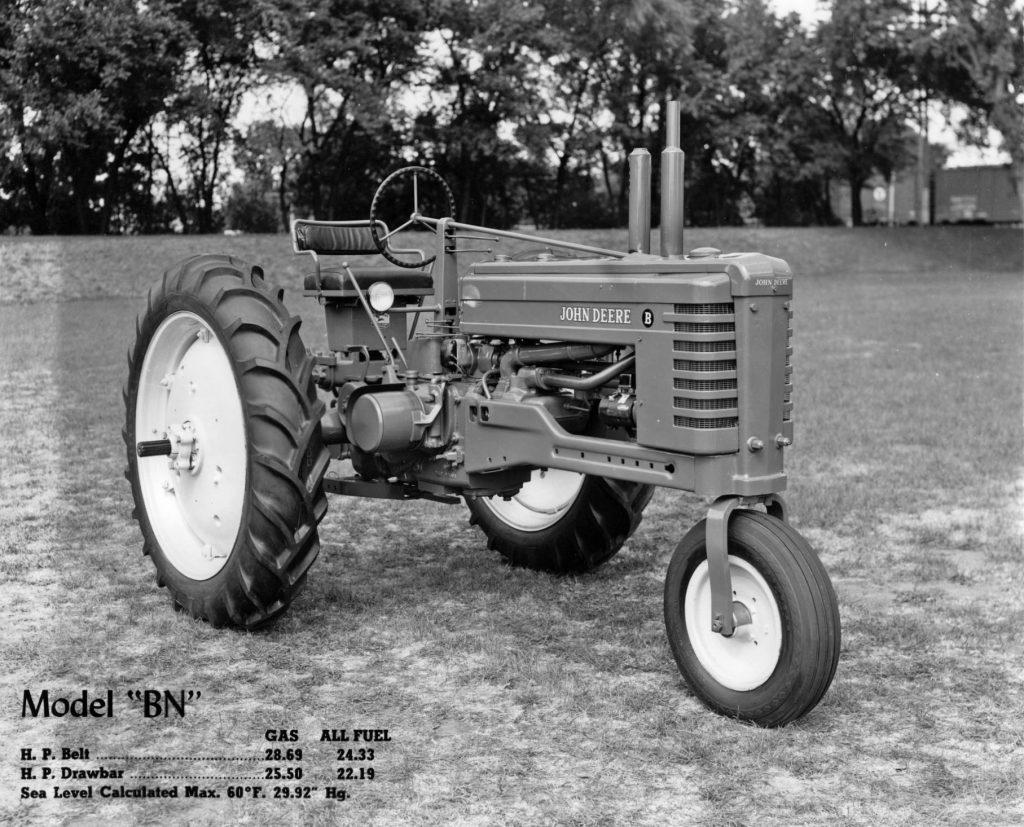
Because of these changes, the flywheel could be contained. This helped to create a safer tractor and was generally considered to be more attractive. While farmers seemed to like the six-speed transmission offered by Deere, the high and low speed versions of the transmission, favored by some farmers in specialized applications, had only limited audiences. This made their production expensive and complicated the company’s parts inventories. Deere decided to revise the transmission ratios in a way that would, hopefully, please everyone.
Finally, it was also noted that farmers were beginning to prefer burning gasoline, as opposed to kerosene, tractor fuel or other heavy distillates in their tractors. One of the reasons behind this shift stemmed in a technological advance realized during the war. Catalytic cracking, a process of refining petroleum, produced more gasoline per barrel of oil than previous methods could and the resulting fuel had a higher octane rating. The first refinery to use this method began operation in Texas in 1943, and by the end of the war, about 300,000 barrels could be processed in the United States each day. This more efficient process brought about a lower cost per gallon of gasoline and made the distillate fuels less economical in comparison. Deere’s tractors had a long-standing reputation for burning the heavy fuels economically and powerfully—their engines were built around their ability to do that—and the sales people sold many tractors by playing up that fact. With this new information from the world of refining, however, Deere was going to have to change its tune quickly.
Deere’s engines may have originally been built to burn heavy fuels, but that does not mean that they could not be engineered to run on gasoline at least as well. Gasoline’s higher octane rating made detonation a less likely occurrence, so compression ratios could be raised, allowing the engine to produce more power without increasing its displacement. Fuel was now less likely to get past the rings and into the crankcase, contaminating the oil. Radiator shutters or screens were not likely to be necessary any longer, either, because gasoline could burn efficiently at a larger temperature range than could distillate.
Besides the obvious positive aspects of burning gasoline, Deere had another reason to develop a gas engine. Aftermarket companies had been producing components to install onto John Deere tractors to convert them to run on gasoline since before World War II. Heads, manifolds, pistons and other parts were all offered to let you run gas through your Deere and deliver more power more efficiently. While some of these devices were well engineered, others were not, but all of them were upsetting to Deere’s engineers. Deere did not want to admit that there was a way to improve on its tractor, nor did it want to watch one burn down due to the addition of poorly engineered aftermarket parts.

Fortunately, Deere had been extensively researching combustion for over a decade. This was necessary to help its tractors run so efficiently on heavy fuels and would prove to be very useful information in development of a gasoline engine. Deere surely had done some research into gasoline engines, as well. One problem that Deere’s engineers had spent time trying to correct, even when running distillate in their engines, was keeping the air-fuel mixture atomized in the cylinder. Because of the large bore in the engine and the slow engine speeds, portions of the fuel tended to drop out of suspension before the firing phase. This led to detonation, even when compression ratios were held back.
Deere’s solution was to modify the intake tract somehow to encourage the fuel to stay in suspension in the mixture. Placing an “eyebrow” next to the intake valve caused the air to swirl on its way into the cylinder. The turbulence caused by this swirling kept the fuel in a more complete suspension and allowed the engineers to ratchet up the compression ratios, creating more power without major engine modifications. Deere’s sales strategists dubbed these new combustion chambers the “cyclone” and used it as a major selling point for their tractors.
After this breakthrough, the rest of the changes on the tractor came fairly quickly and the first experimental versions of the new “B” were in the field in 1945. After testing, the design was approved for production in 1946, but did not begin until early 1947. After the end of the war, companies throughout the country needed massive amounts of new tooling to get back into full production of whatever they had prepared during the war. Deere’s first priorities were to begin building the model “M” tractor so much of the tooling and machinery that they got first went to Dubuque. The production of the model “M” tractor allowed Deere to stop production of the “H” and “BR”/”BO” tractors, freeing room in Waterloo. Deere also had backed up orders to fill before it could begin producing new tractors. In February of 1947, however, the company was ready and work on the first new model “B,” serial number 201000, began.
The new “B” could be ordered with either a gasoline or all-fuel engine. Each of these engines had a bore that was increased by 3/16ths of an inch to 4-11/16th, giving them 190 cubic inches of displacement. Engine speed was also increased to 1250 RPM. The all-fuel engine gained nearly four horsepower at the belt, bringing it to 24.33 horsepower. Most of this was due to the cyclone engine; the displacement increase mostly helped to provide more horsepower. The gasoline engine provided 28.69 horsepower at the belt.
Deere had revised the six speed transmission in the “B” for the new version. A creeper gear of 1-1/2 miles per hour was incorporated and revised ratios allowing travel at 2-1/2, 3-1/2, 4-1/2, 5-3/4 and 10 miles per hour provided enough speeds in the working range to eliminate the old high and low speed special transmissions. This new transmission was the first by Deere that controlled six speeds with one shift lever.
As promised, electric starting and lighting, with sealed parts throughout, were incorporated, as was an enclosed flywheel. The battery was moved under the seat and a new cushioned seat was placed over it. This seat was adjustable forward and backward and was much more comfortable than the old one, even without any sort of suspension. The arrangement also cleared up the operator’s platform, making it more spacious. The throttle and shutter controls were moved to be more convenient to the operator. All together, the machine was a much more comfortable version compared to the old one.
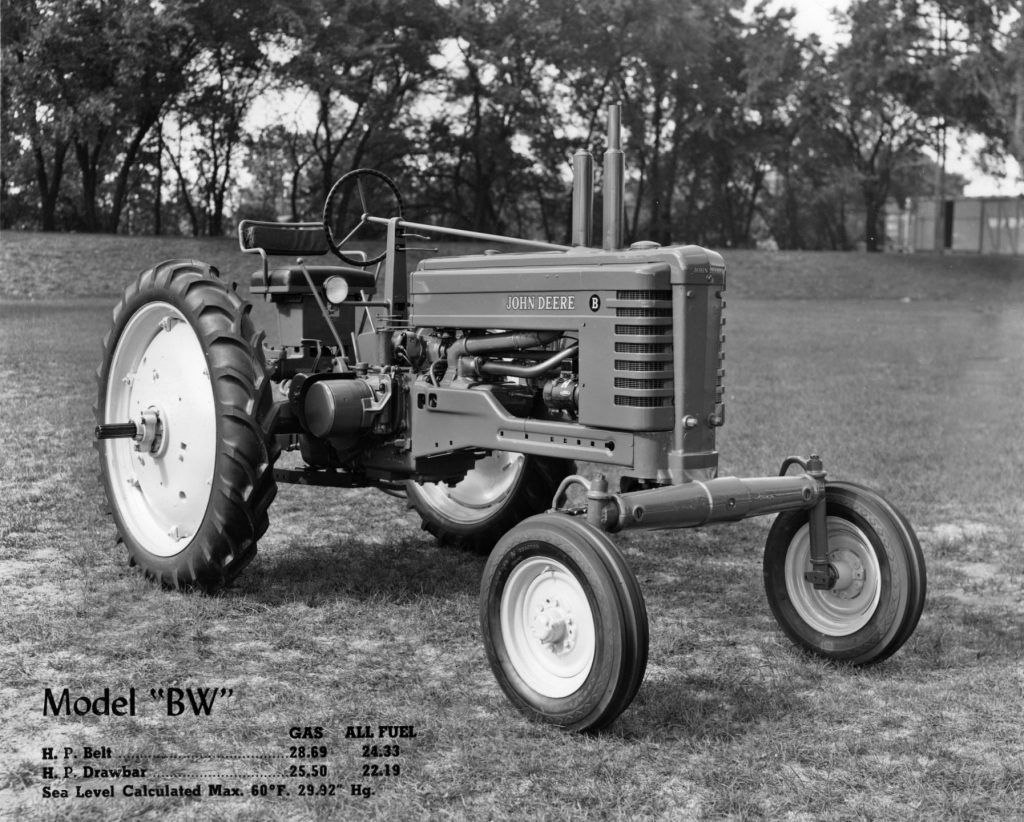
Also benefiting the comfort of the operator was a new optional Roll-O-Matic front end. This narrow front had a built-in suspension system that made the ride smoother and made steering easier. Hydraulics became standard equipment on the tractor. Deere’s engineer’s crowning wartime achievement, Powr-Trol, was also standard equipment. Powr-Trol was the world’s first hydraulic system that allowed precise control of the hydraulic cylinders or the rockshaft. Powr-Trol was so popular that Deere could not build it as fast as it was ordered. Deere was willing to furnish a Power Lift unit to tractors whose owner wanted Powr-Trol but could not get it. Powr-Trol units were equipped later for the farmer. Power Lift was also available as an alternative to the Powr-Trol. If a farmer had no use for hydraulic equipment, the lot could be left off and a cost savings imparted.
The new “B” also had a front end support made of pressed steel rather than cast iron. These eliminated the need for spark plug covers. Some say that this pressed steel added style to the tractor, smoothing the line along the length of it; others prefer the heavy and rigid look of the old iron support. To each their own. When new, the steel supports were said to be stronger than the iron version, but when used for long periods with heavy front end equipment, they have proven to be more likely to fail.
Deere eliminated the models “BNH” and “BWH” before releasing the newest model “B” tractors. These specialty models had never really sold well and were cumbersome to deal with in production, inventory and service. Deere replaced these tractors with new versions of the “BN” and “BW.” These tractors had a new two-piece front pedestal and both wide and narrow front equipment could be attached to it. This way, both tractors were built identically until it came to the front end equipment and an operator could switch equipment at some point if they pleased.
While no “BNH” or “BWH” tractors were built after serial number 201000, a farmer could purchase 42 inch rear tires and corresponding front end equipment to give a tractor extra clearance, if desired. Despite the fact that these tractors may have been higher than their counterparts with standard wheel equipment, they were still just a “BN” or “BW.”
The new “B” tractors sold very quickly. The increase in horsepower did not bring them into the next plow class—which was fine, as Deere already had a fine tractor there—but it did increase the speed at which a farmer could get a job done. A two-bottom plow could often be pulled one-half mile per hour faster or more and the tractor could now easily handle a four-row cultivator. Other equipment that was previously out of reach of the power of the “B” was now in it, making the tractor even more useful (and popular) than before.
Deere did not have to change much on the model “B.” Apparently the engineers did their jobs and had kneaded out all of the lumps before production. The Wico X magneto replaced the Wico C at serial number 217799. A one-piece brake shaft was used beginning at number 232468. Distributor ignition was made standard at serial number 268820. The Wico XD distributor was used at this time. Magneto ignition was still left as an option, though.
People buying the model “B” began to get jealous of the two-piece front pedestal on the “BN” and “BH,” so Deere offered it as an option on the “B” beginning at serial number 259371, as well as equipment to convert earlier tractors. A Roll-O-Matic version built for this pedestal was made available, as well. Deere then officially changed the rear axle housing from “round” to “square” at serial number 260984. Some earlier tractors have been found with the “square” housing, however. Except for some “BN” and “BW” tractors built very late in production, these tractors continued with the “round” housing.
The old right angle fenders were replaced with “clamshell” fenders at about the same time as the axle housing change. These were considered more attractive and would not plug with mud, but were not quite as protective as the old version. Tractors with “round” axle housings could be fitted with an adapter bracket to furnish them with the new fenders.
The tractor born of ideas brought forth during World War II had to adapt to an issue created during the Korean War. A copper shortage caused during that war caused Deere to fit the model “B” with radiators with steel cores. Because steel is less efficient in cooling than is copper, Deere added a water pump in the bottom of the radiator tank. This happened at serial number 306600. The thermo-siphon cooling system was about at capacity with the new engine anyway and the new system actually worked better, even without copper.
The last “B” series tractor was built on June 2, 1952. Serial number 310772, an all-fuel “B” was the last after 17 years of production. In five years of selling these late model “B” tractors, 109,253 were sold and over 88 percent of these were gasoline tractors. That was a lot of tractors, though the model “A” had come up to become Deere’s most popular tractor of the period.
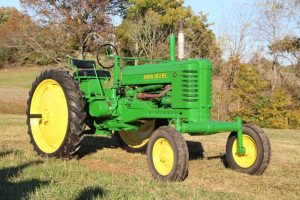
Finding a model “B” for your collection may be one of the easiest things that you can do, as they are extremely common. Even the “BW” and “BN” tractors are not very rare, unless you are looking for an all-fuel version. The good news, then, is that you can afford to be picky in your search. If you spend a little time, you may have the chance to take your pick out of several tractors in your area.
The “B” was painted green with yellow wheels and semigloss black generators and light housings. Early models had gauges with white faces and gauges with black faces were used beginning at about serial number 306600. Seat cushions were black. Decals should be obtained from a reputable source (not a Deere dealer) and placed according to their instructions. From 1947-1950, the “John Deere” hood side decal was centered. After that, the leading edge of the decal began at 1-1/2 inches from the seam between the hood and the grille. While Deere and Company did not document this change, evidence points to this timing as a most likely scenario.
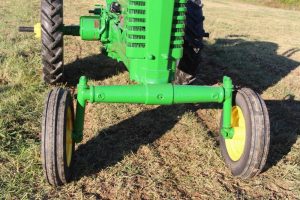
The “B” was popular when it was new, remains so today and probably will be until they all return to dust. These tractors had power that belied their small stature and will often surprise fans and competitors alike at antique tractor pulls by out-pulling older model “A” tractors. Whatever reason your desire to own one of these machines stems from, you can find one for your purpose. The “B” was John Deere’s most popular tractor of all time, and as far as power and capability are concerned, these late machines are its optimum form.
Story by Benjamin Hain.
Originally published in the February 2012 issue of Green Magazine, the #1 magazine for John Deere tractor, equipment, and memorabilia enthusiasts.
Follow this link, https://greenmagazine.com/ for more John Deere stories from Green Magazine.

